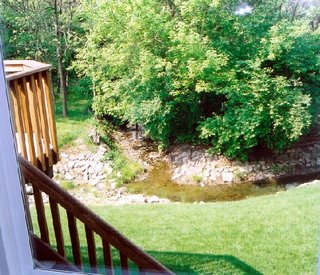Rain, Part 1
 At our old house, we had a lovely meandering stream that ran through our back yard. It was one of my favorite things about that house. It was really pretty, and it brought all kinds of wildlife.
At our old house, we had a lovely meandering stream that ran through our back yard. It was one of my favorite things about that house. It was really pretty, and it brought all kinds of wildlife.Unfortunately, it also brought beer cans, plastic bottles, plastic bags, and even occasionally logs and landscaping timbers. Why? Because so much water was channelled into it when it rained, it turned from a meandering stream into a raging torrent. Our property extended to the far side of the stream a little ways, and I remember a friend or relative suggesting a little decorative bridge, or a gazebo on the far side.
 It didn't really appeal to me - I like my nature au naturel - but I shudder to think what would have happened if I'd pursued the idea.
It didn't really appeal to me - I like my nature au naturel - but I shudder to think what would have happened if I'd pursued the idea.After reading an article on the National Wildlife Federation's Backyard Wildlife Habitat site, I decided to build a brush pile on the far side of the stream. I needed to cut down the invasive shrub honeysuckles anyway, so I was getting a two-for-one deal. The brush pile was probably four feet high, and ten or fifteen feet across. The first hard rain, it was gone. Completely. No trace of it.
Luckily the floodplain was away from us. But there was a drainage pipe that fed into the stream. It went under the road, under much of our side yard, through some big rocks, and then into the stream. It would turn into a frightening blast of water during storms. Rocks the size of a microwave oven would get tossed about in it. When we moved in, the banks of the stream were were lined with nice flat, decorative rocks (see first photo). By the time we moved out a few years later, most of the rocks were washed down into the stream, and the banks were starting to erode. The 30-foot tree (never did figure out what kind) was getting it's root mass undercut. I tried to plant various things on the stream banks to hold them, but most plants couldn't put up with going from the heat radiating off the rocks to submerged in Class III rapids and back again.
Why am I telling you this? To illustrate what rainwater runoff can do. When you start talking about things like rain barrels and cisterns, people usually think of one of two things: old rural houses (a West Virginia holler) or desert environments (gardening in Phoenix). Why would somebody install rainwater collection in the suburban Midwest? Or in the country for that matter, since you've got free well water?
There are a lot of reasons. Rainwater runoff is one. As more and more subdivisions are built, the flow of water is redirected, restricted, and not always well thought out. And despite the prevailing culture that says everything is in infinite supply, water supplies are not free. City water has to be treated, often with lots of chlorine and flouride and such, and well water is often treated with water softeners and rock salt. Why not spare your garden the chlorine or salt residue, or hard, cold well water?
Underground aquifers are not unlimited, for that matter. In some Great Plains states in the Western U.S., groundwater is being removed 100 times faster than it can be replenished in the huge Ogallala Aquifer.
Underground aquifers are not unlimited, for that matter. In some Great Plains states in the Western U.S., groundwater is being removed 100 times faster than it can be replenished in the huge Ogallala Aquifer.
Something as simple as a rain barrel cuts down on several problems. It reduces runoff, which reduces flooding and erosion. It reduces the need for water treatment. It reduces the use of aquifers. It provides soft, temperate, free water for your garden and your flowerbeds.
And yes, this is probably a very weird topic for October, but Beo started it!
Next I'll describe how I set mine up, what mistakes I made, and what lessons I learned...
And yes, this is probably a very weird topic for October, but Beo started it!
Next I'll describe how I set mine up, what mistakes I made, and what lessons I learned...
Labels: projects


3 Comments:
Can't wait to see this. My dad and I were talking recently about alternative energy sources, solar-heated water, and such. This project sounds like it would fit in with our thinking on improvements to the farm.
When I was growing up, we caught rainwater from some of our downspouts in 55 gallon drums with overflow spouts. Then we would fill empty milk jugs from spigots in the side of each barrel, much like large iced-tea jugs, and carry that 100yds to the garden.
A more efficient, well planned setup would cost some cash, but should provide MUCH more benefit, especially if runoff from house, barn, machine shed, and garage could somehow be collected into one place.
I can't wait for the next post. We are demolishing an old shed this fall and building a new one in it's place, and we have already planned to collect rainwater for watering the gardens.
We were just going to do the old 55 gallon drum with spigot, but I bet yours will be better and more efficient! Tell me more!!
Thanks for the plug E4! Matt, I will have a 55 gallon barrel at the head of each of my garden beds next yera, that I will fill off of my rain barrels-which happen to be 15 feet higher altitude. Hose hooks ups should do the rest!
Post a Comment
<< Home